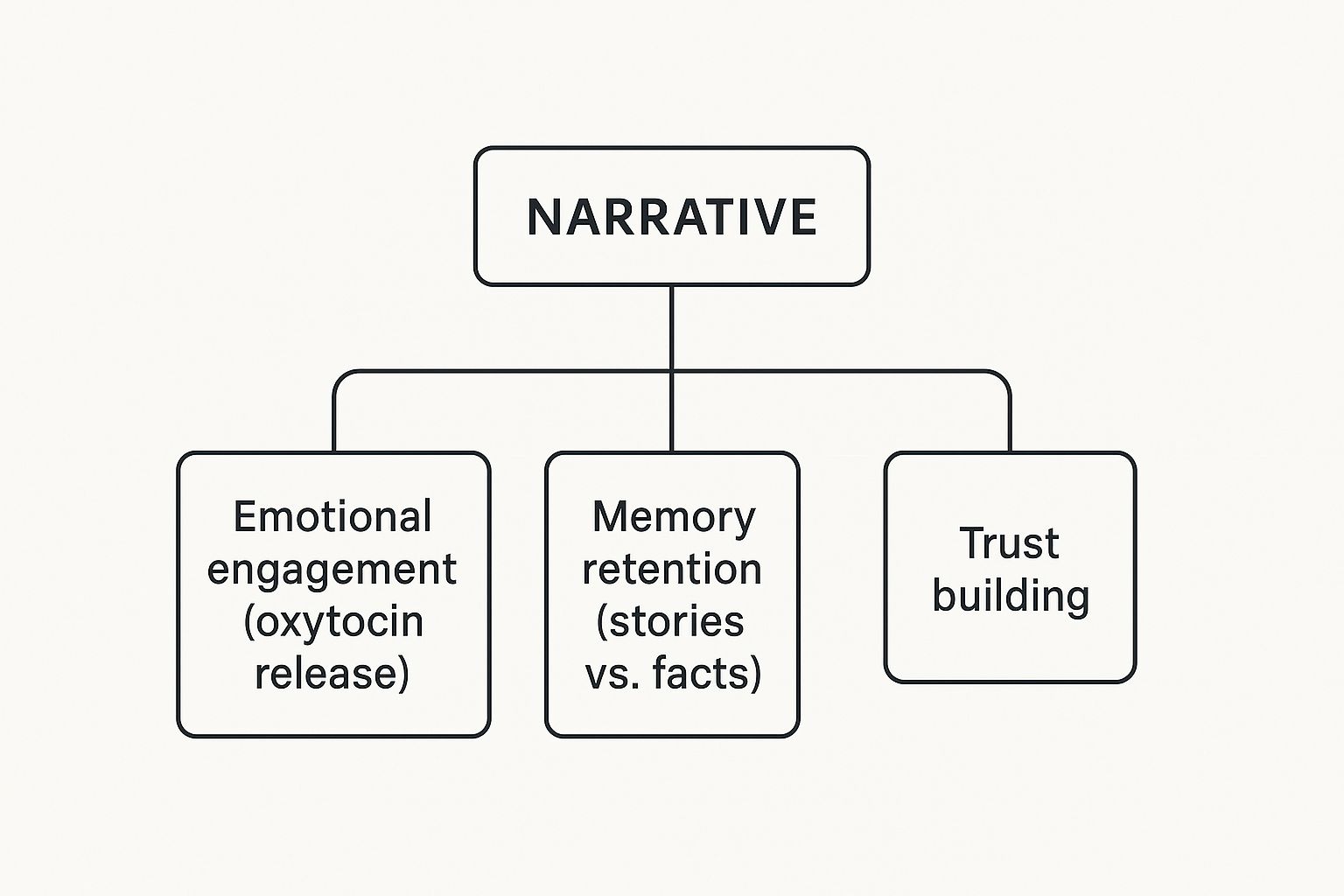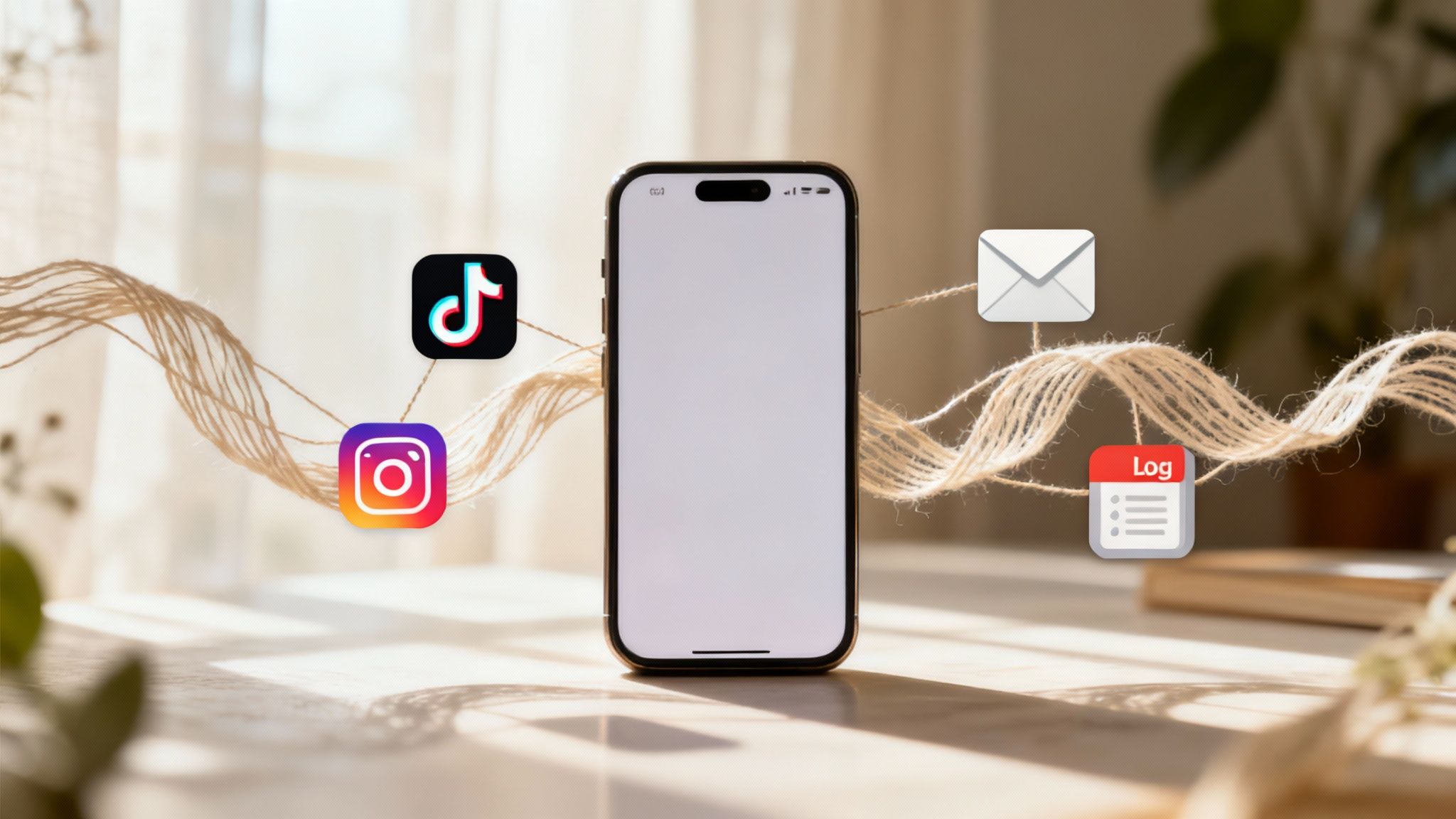
In a crowded digital world, shouting about your product features isn't enough to capture attention. Brands struggle to connect, with their content often lost in the endless scroll. The real challenge isn't being louder; it's being more human. So, how do you build a genuine connection that turns casual followers into loyal customers?
The answer lies in mastering storytelling in digital marketing. This isn't just a creative flourish; it's a strategic tool for forging an emotional bond with your audience. This guide will show you how to move beyond dry facts and features to craft compelling narratives that resonate, build trust, and drive meaningful growth.

Why Your Brain is Wired for Stories
Ever notice how you can get lost in a good book but a list of facts makes your eyes glaze over? That’s not a coincidence—it's human biology. Our brains are hardwired for narrative. When you hear a fact, only the language-processing parts of your brain activate. But when you hear a story, your brain lights up. The sensory and motor cortices fire up as if you're experiencing the events yourself.
This deep engagement is what makes storytelling a marketing powerhouse. A great story doesn't just inform; it creates an experience that triggers a powerful neurochemical response.
- Oxytocin: Known as the "trust hormone," it's released when we feel empathy for a character, fostering connection and generosity.
- Dopamine: A story's climax and resolution trigger a dopamine release, which enhances pleasure and, crucially, memory.
- Cortisol: A narrative filled with tension grabs our attention by releasing cortisol, focusing our minds and keeping us hooked.
This is why information delivered in a story can be up to 22 times more memorable than the same information presented as a list. Facts inform, but stories persuade. They bypass the brain’s natural resistance to being sold to, creating a connection that builds lasting trust.

Proven Storytelling Frameworks for Marketers
Knowing you need a story is one thing; building one that consistently connects is another. Instead of starting from scratch, marketers can use proven storytelling frameworks as reliable blueprints. These structures help ensure your storytelling in digital marketing is effective and consistent across every channel, from social media ads to in-depth case studies.
Think of these frameworks as recipes: you bring your unique ingredients—your brand's voice, your customer’s pain points, and your solution—while the structure guarantees a satisfying result.

Comparing Classic Storytelling Frameworks
Different frameworks serve different purposes. Some build epic brand narratives, while others are designed for quick, high-conversion messages. Here's a breakdown of the classics:
| Framework | Core Concept | Best For | Example Use Case |
|---|---|---|---|
| The Hero's Journey | The customer is a hero on a quest, and your brand is the wise guide who helps them succeed. | Building long-term brand affinity and emotional connection through large-scale campaigns. | A software company showcasing a user who overcomes business challenges and achieves career growth using their tool. |
| Before-After-Bridge | Show the customer's current frustrating reality (Before), paint a picture of their ideal future (After), and present your product as the solution (Bridge). | High-conversion assets like landing pages, email marketing, and social media ads where you need to communicate value quickly. | A fitness app ad showing a person struggling with motivation (Before), then feeling energetic and confident (After), with the app as the Bridge. |
| Problem-Agitate-Solve | Identify a customer pain point (Problem), dig into why it's so frustrating (Agitate), and then introduce your product as the clear resolution (Solve). | Direct response copywriting, sales pages, and video scripts that need to grab attention and drive immediate action. | A cleaning product ad that starts with a stubborn stain (Problem), shows the homeowner's frustration trying to remove it (Agitate), and then easily wipes it away with the product (Solve). |
Real-World Use Case: The Hero's Journey
The Hero's Journey is a classic for a reason. In marketing, the golden rule is simple: your customer is the hero, not your brand. Your role is the mentor who provides the tools and wisdom for their success.
A marketing agency could use this framework to tell the story of a client, a small e-commerce startup (the hero), struggling with low visibility (the challenge). The agency (the mentor) provides a new digital strategy (the tool). The hero implements it, overcomes the obstacle of obscurity, and returns transformed with record-breaking sales. This narrative positions the agency as an empowering guide, not just a service provider.
To truly master these structures, brush up on core copywriting tips for beginners and explore powerful visual storytelling techniques to make your stories unforgettable.
Adapting Your Story for Every Digital Channel
A powerful brand story needs the right stage, but not every stage is the same. The art of storytelling in digital marketing lies in adapting your core narrative to fit the unique audience and format of each platform. A story that resonates on your blog might fall flat on TikTok if the delivery isn't right.
The goal is to create a seamless experience where every touchpoint—from an Instagram Reel to an email newsletter—reinforces the same central message. This consistency builds trust and makes your brand feel authentic and reliable wherever your audience finds you.

Tailoring Your Narrative by Platform
Think of your core story as the plot of a movie; each channel is a different scene, told in a style that fits the moment.
- Short-Form Video (TikTok & Reels): These platforms demand energy and authenticity. Focus on a single emotional hook—a surprising "aha" moment, a relatable creator struggle, or a quick win. Behind-the-scenes content and user-generated clips work exceptionally well here. For example, a freelancer could show a 15-second "before-and-after" of their chaotic workspace transformed by a productivity tool.
- Immersive Visuals (Instagram): Use carousels and Stories to unfold a narrative step-by-step. The first slide must grab attention, the middle slides build the story, and the final slide provides a call to action. A startup could use a carousel to tell its founding story, with each slide revealing a new chapter in their journey.
- Long-Form Content (Blogs & Podcasts): Your blog is the home base for your most detailed stories. Use it for in-depth case studies, thought leadership articles, and comprehensive guides. To expand your reach, transform articles into engaging podcast content for audiences on the go.
- Relationship Building (Email Marketing): Email allows for more personal, intimate storytelling. Share your origin story in a welcome sequence or feature customer success stories in weekly newsletters. The tone should be conversational and value-driven.
Using a tool like social media automation software can help you manage and schedule this tailored content across all platforms efficiently.
👉 Try MediaWorkbench.ai for free – schedule your posts and generate AI content in one place!
Examples of Storytelling That Built Empires
Theory is one thing, but seeing masterful storytelling in digital marketing in action is what truly inspires. The brands we remember don't just sell products; they invite us into a world we want to be part of. By making the customer the hero, they build a loyal community that lasts long after a purchase is made.
Case Study: Dove's "Real Beauty" Campaign
Before its "Real Beauty" campaign, Dove was just another soap brand. Then, by featuring women of all shapes, sizes, and ethnicities, Dove started a global conversation about unrealistic beauty standards. The campaign's genius was its authenticity.
- The Goal: To build deep brand loyalty by challenging narrow beauty ideals.
- The Framework: Dove used a "Problem-Agitate-Solve" model. They identified the problem (low self-esteem caused by media), agitated it with emotional videos like "Sketches," and positioned Dove as the solution—a brand celebrating real beauty.
- The Result: Sales jumped from $2.5 billion to over $4 billion, proving that a story with a purpose can build an empire.
Case Study: Airbnb's "Belong Anywhere" Campaign
Airbnb had to overcome a huge hurdle: convincing people to stay in a stranger's home. They did it not by talking about amenities, but by telling stories about human connection.
- The Goal: To build trust and shift the focus from transactions to experiences.
- The Framework: Airbnb masterfully used the Hero's Journey, positioning its users as the heroes of their own travel adventures. The platform was simply the guide enabling their experiences.
- The Result: By showcasing real stories from hosts and guests, Airbnb transformed sterile listings into backdrops for connection and belonging, turning a risky proposition into a global movement.
Creating authentic content at this scale can be challenging, but exploring the best AI tools for content creation can help your team streamline the process.
How to Measure the ROI of Your Storytelling
Storytelling is a creative art, but it must deliver tangible business results. To justify the effort, you need to connect your narratives to clear key performance indicators (KPIs). This means moving beyond vanity metrics like likes and shares to measure how your stories influence audience behavior and contribute to business growth.
The goal is to draw a direct line from your creative work to your bottom line.
Key Metrics for Storytelling Success
- Audience Retention & Completion Rates: On videos, a completion rate above 50% indicates your narrative is captivating. For blog posts, use scroll-depth tracking to see if readers are reaching the end. High retention proves your story is holding attention.
- Brand Sentiment Analysis: Use tools to track online mentions and analyze the emotional tone. A positive shift in sentiment after a story-driven campaign is a significant win.
- Lead Conversions from Story-Based Content: Use UTM parameters in links within your blog posts, video descriptions, and emails to track exactly how many leads or sales originate from a specific story. This shows which narratives are most effective at driving action.
- Customer Lifetime Value (LTV): Compare the LTV of customers who engaged with your story-driven campaigns versus those who didn't. A higher LTV in the engaged segment is powerful proof of ROI.
Connecting your creative efforts to data is crucial. For more on this, our guide to marketing automation best practices provides valuable frameworks for measuring impact.
Start Telling Your Brand's Story Today
We've explored the psychology behind why stories work, the frameworks that give them structure, and the strategies for adapting them across digital channels. The key takeaway is simple: storytelling is not just another marketing tactic. It's the most powerful way to weave your brand into the lives of your customers.
The brands that win are those that tell authentic, human stories. By shifting your focus from selling to connecting, you're not just acquiring customers—you're building a community of loyal advocates. Your next step is to find your brand's core truth, choose a framework, and start sharing your story. That is how you turn passive scrollers into passionate fans.
👉 Ready to bring your brand's story to life? Try MediaWorkbench.ai for free and start creating compelling content that connects.

